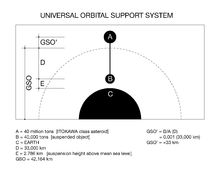Universal Orbital Support System
A Universal Orbital Support System[1] is a concept for suspending an object from a tether orbiting in space.

Explanation
[edit]Background
[edit]A concept for providing space-based support to things suspended above an astronomical object. It is envisioned as a type of non-rotating tethered satellite system. The orbital system is a coupled mass system wherein the upper supporting mass (A) is placed in an orbit around a given celestial body such that it can support a suspended mass (B) at a specific height above the surface of the celestial body, but lower than (A). The relationship between (A) and (B) is such that it (A) moves higher as (B) is lowered towards the surface, the distance is related as an inverse proportion of their masses.
Example
[edit]This system has been proposed for the Analemma Tower[2] concept, which employs the system to suspend a building from a cable supported by an asteroid orbiting Earth.[3]
See also
[edit]References
[edit]- ^ "Analemma Tower". Clouds AO. March 2017.
- ^ Wood, Charlie (March 29, 2017). "A 20-mile long 'spacescraper' dangling from an asteroid: Could it work?". www.csmonitor.com.
- ^ Clouds AO (2017-04-03), Analemma Tower - Clouds AO, retrieved 2017-04-04
